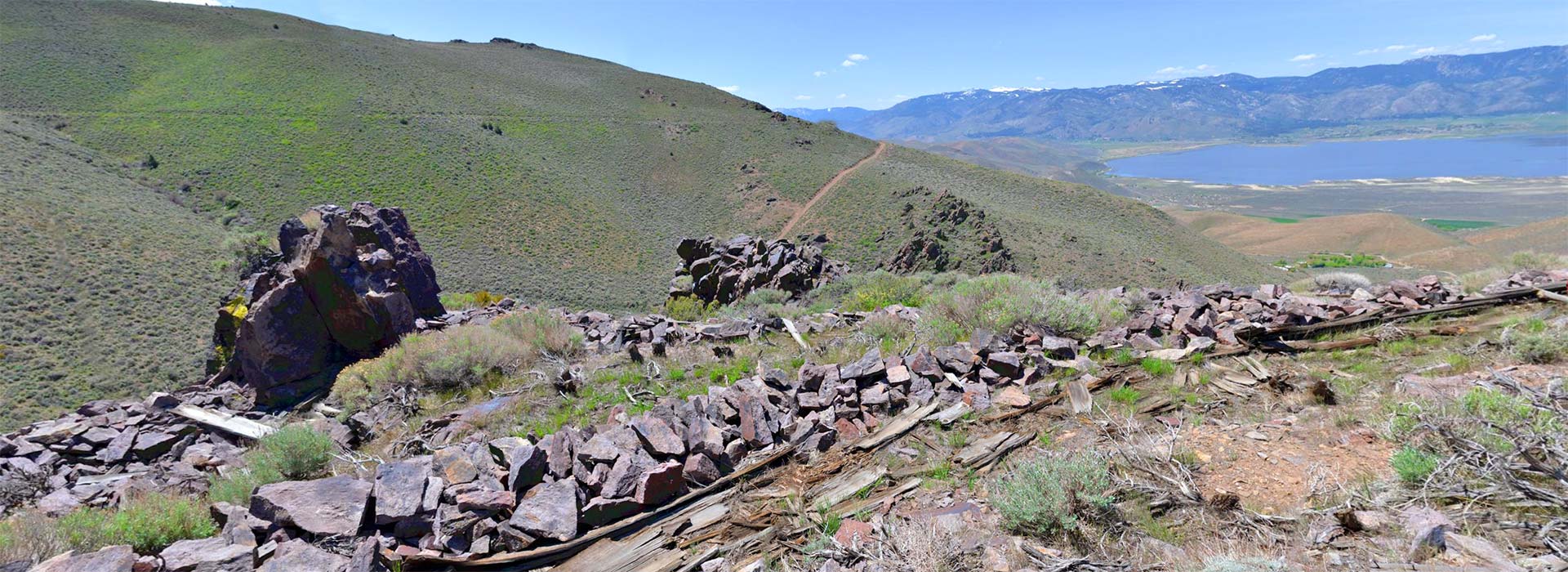
20 May 1873 Wooden Box Flume
Water was first brought to the Comstock by natural springs and wells nearby. Usually, however, by autumn the water supply became insufficient. An audacious solution was proposed: to bring water from the ample snow-melt sources high up in the Sierras across the Washoe Valley. This six-node virtual reality environment presents different views of the remnants of the box flume west of Virginia City as well as the eastern end of the pressure pipe.
Click here to see the location of the pipe/flume junction in Google Maps. Click here to see the Hobart Creek Reservoir water source.
First, a diversion dam had to be constructed on Hobart Creek, together with long lines of box flumes. Then a pressure pipe across the Washoe depression was needed. This was an unprecedented undertaking as the anticipated pressure in the pipe, due the height of the water source, was much greater than had ever before been attempted. This problem was solved by the use of iron plates bent to a cylindrical shape and riveted to form a pipe.
Surveys were made in the spring of 1872, and manufacturing of the pipe was begun in San Francisco. Twelve inches in diameter, varying in thickness depending on the water pressure to be encountered, the pipe was made up in 26-foot lengths. It weighed a total of 700 tons and stretched for 7 miles when installed.
Construction of the other portions of the aqueduct was carried on at the same time that the pipe was being manufactured and installed. From the diversion dam on Hobart Creek a wooden flume, 18 inches deep and 20 inches wide, 4.62 miles in length, was built along the mountainside, leading to a tank where the water entered the pressure pipe. From the outlet of the pressure pipe on the other side of the Washoe depression another flume, the one seen on this page, was constructed. It snaked downhill along the western flanks of McClellan Peak for 4.04 miles, leading to a saddle where Five-Mile Reservoir was constructed. The flume was 16 inches by 18 inches in section. From the reservoir site the flume continued a final 5.66 miles to Gold Hill and Virginia City. Water reached these thirsty Comstock towns on the night of August 1, 1873. Journalist Dan DeQuille (William Wright) described the rejoicing:
Cannons were fired, bands of music paraded the streets, and rockets were sent up all over the city. Many persons went out and filled bottles with this first water from the Sierras.
The system, more than 21 miles in length, was capable of delivering 2,200,000 gallons a day. By 1887, water from Marlette Lake was being flumed through a tunnel to augment the water of Hobart Creek, and a total of three pressure pipes were installed. When completed, the water supply system included three reservoirs, more than 21 miles of pressure pipes across the Washoe depression, and approximately 46 miles of covered box flume and the tunnel. The total investment was in excess of $3,500,000.
Text adapted from the 1969 state legislative report which may be read in its entirety here. Thanks to TA Taro for guiding us to this spot.




No Comments